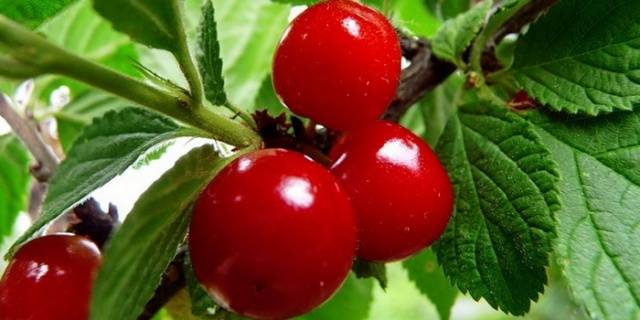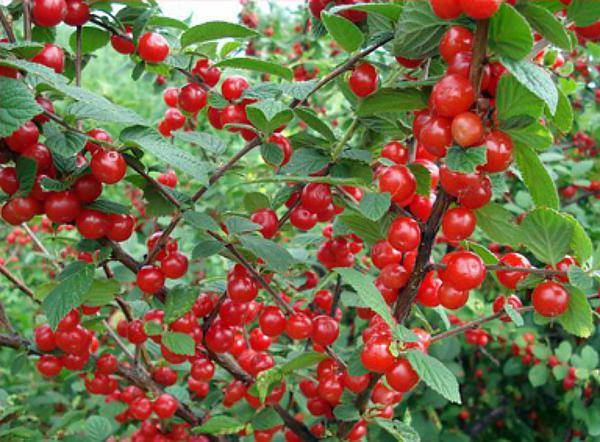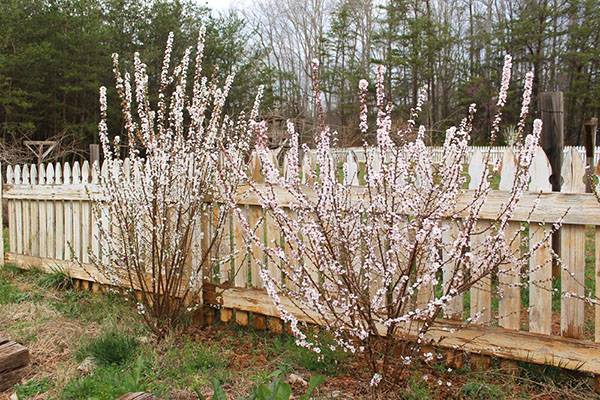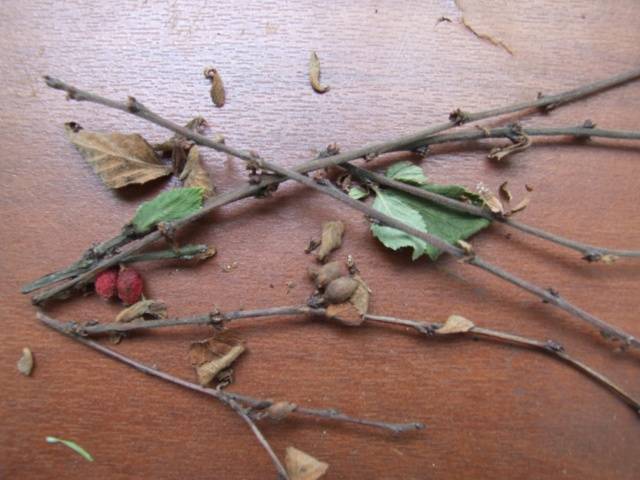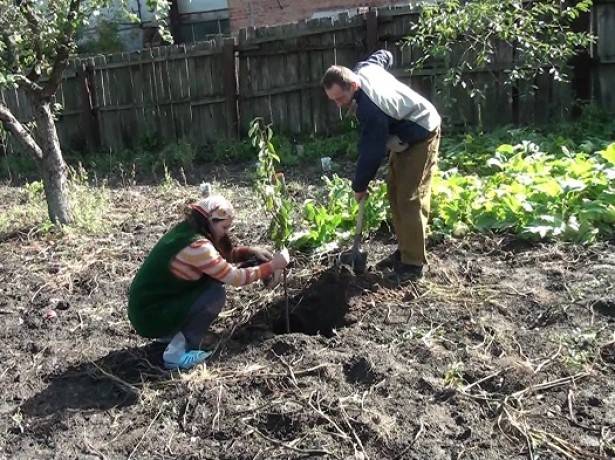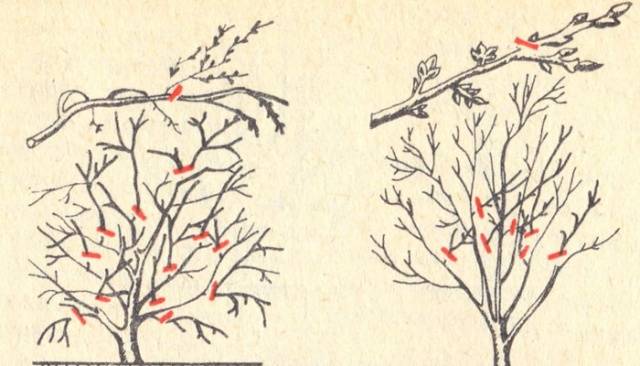Content
Natalie is one of the most popular felt cherries. Due to its undemanding care and universal characteristics, it has long earned approval among professional agronomists and amateur gardeners.
Breeding history
Felt cherry variety Natalie was bred in 1979 in the Far East, at the experimental station of the V.I. N. Vavilova. The parent variety for him was Leto, pollinated with mixed pollen from Damanka, Red Sweet and Ogonyok.
The authors of Natalie are named V.P. and N.A. Tsarenko. Work on bringing it out cherry varieties were conducted for 20 years.
Natalie was added to the State Register in 1997.
Description of culture
Felt cherry Natalie is a tree-like spreading shrub from 1.7 to 2 m in height.
The bush is wide, ovoid or slightly flattened oval in shape, has a medium thickening. Perennial branches are thick, gray, covered with rough bark. Young shoots are greenish brown.
Buds are small, pointed, slightly deflected from the shoot. Natalie's leaves are light green, small (up to 6 cm long), wrinkled, with a pointed tip. The edge of the leaf blade is corrugated. The petiole is 7 mm long and medium thick.
The flowers are numerous, large (from 2 to 2.5 cm in diameter), saucer-shaped. Initially, they are white-pink in color, after a week they fade and become completely white. There are five petals. The flowering type is solid, this applies to all branches (both annual and perennial).
Fruits of the Natali variety are very large for felt cherries (weighing up to 4 g). In shape, they resemble a wide oval, tapering downward. The peduncle is short (about 4‒5 mm), slightly pubescent, separates from the fruit without effort. The skin is dark red, covered with short, barely visible hairs. The pulp is scarlet, dense, juicy, with small cartilages (like a cherry fruit). The seeds of the Natalie felt cherry are beige, oval, small (only 5% of the total fruit weight). Fruit taste is harmonious, sweet with pleasant sourness.
Natalie's life expectancy with proper care is up to 18 years.
Due to the universal characteristics of this variety, the cultivation of Natalie felt cherry is recommended in all regions of Russia. It is suitable for breeding in nurseries, in intensive orchards (with close proximity to fruit processing points), as well as for amateur gardening.
Characteristics
Drought resistance, winter hardiness
Natalie is a variety of felt cherry characterized by high winter hardiness. The trunk and branches of the bush are able to withstand frosts down to -35 degrees. Flowers tolerate spring frosts well (up to -3 degrees).
This variety is highly resistant to drought.
Pollination, ripening dates and flowering period
Felt cherry Natalie belongs to the early varieties. It blooms about May 20-27, the fruits ripen in the first or second decade of July.
The variety is self-fertile.Natalie's felt cherry pollinators should grow in the same area and bloom at the same time.
In this role, they can perform well:
- plum;
- peach;
- apricot;
- cherry plum;
- cherries of other felt varieties.
Productivity, fruiting
Natalie's felt cherry seedlings begin to bear fruit in the second year. The variety is characterized by a high yield - 7-10 kg can be harvested from a bush. The berries ripen in large quantities and at the same time.
Natalie felt cherries are much less acidic than common cherries. There is no astringency in their taste. In their composition: 12% dry matter, 8.3% sugar and 0.8% acids. The content of ascorbic acid in 100 g of the pulp of Natali berries is 24 mg.
Tasting grade Natali - 3.8-4 points (with a maximum of 5).
Fruit transportability is low. They should be collected exclusively by hand. Natalie berries can be stored in the refrigerator for no more than 6 days. And only 3 days - at room temperature. It is advisable to recycle them immediately after collection.
Scope of berries
For economic purposes, the fruits of the Natalie felt cherry are considered universal. They are eaten fresh and are also used to make juice, preserves, marmalades, jam, marshmallows and marmalade. Natalie berries make delicious wines and liqueurs.
Disease and pest resistance
Like most varieties of felt cherries, Natalie is highly resistant to coccomycosis, a formidable enemy of the common cherry.
This variety is relatively resistant to clasterosporium disease.
Monilial burns (a fungal disease affecting the plant during the flowering period) pose a significant danger to Natalie.
Felt cherries are distinguished from pests:
- rodents (primarily mice);
- pocket and gall mites;
- aphid;
- weevil;
- shield.
Advantages and disadvantages
| Benefits | disadvantages |
| Early variety | Self-infertility |
| High yield | Does not tolerate waterlogging |
| Large and tasty fruits | Fruit size becomes smaller with excess harvest |
| Frost and drought resistance | Poor transportability of fruits |
| Coccomycosis resistance |
Landing features
Recommended timing
Planting Natalie's Felt Cherry can be carried out:
- early spring (preferred);
- autumn (in September).
When planting in spring, young plants will have time to take root better and endure the cold more easily.
Choosing the right place
The place for Natalie's landing in the ground should be sunny, the acidity of the soil should be neutral.
Optimal soil types:
- peat;
- sandy loam;
- loam.
An important characteristic of the Natali felt cherry is the intolerance of excess moisture in the soil. It should be planted in places where there is no stagnant water, and where groundwater does not come close to the surface.
What crops can and cannot be planted next to cherries
Next to the Natalie bush, it is recommended to plant:
- trees are potential pollinators;
- elderberry;
- lilies of the valley, violets, periwinkle.
Do not plant in the neighborhood:
- coniferous trees;
- nightshade plants;
- hazel;
- currants, gooseberries, raspberries.
Selection and preparation of planting material
Planting material is one- and two-year-old seedlings.
Immediately before planting in the ground, the roots of young plants should be cut off (by about 20 cm), and then dipped in a water mash made of clay.
Landing algorithm
Basic landing techniques:
- the seedling hole should be about 60 cm wide and 50-80 cm deep;
- a mixture of humus and fertile soil, supplemented with slaked lime and complex fertilizer, is laid on the bottom of it;
- the seedling is installed in a hole, making sure that the root collar is not deeply buried, after which it is covered with ready-made soil;
- the ground is carefully compacted and watered (1 bush needs 20-40 liters of water).
Follow-up care of the culture
Natalie's felt cherry is pruned in spring. For a tree under 5 years old, a crown is formed in this way, while an older plant requires it as a rejuvenating procedure. Regular and correct pruning can almost double the lifespan of a cherry, without it being about 10 years.
Natalie should be watered very sparingly, no more than 3-4 times during the season, especially during the dry season, making sure that the root collar does not undermine.
To feed Natalie's felt cherries:
- in the spring (with mineral fertilizers);
- autumn (organic).
In the fall, when the crop has already been harvested, you should carefully loosen the soil in the near-trunk circle, carefully inspect the shrub, removing dried and spoiled branches. It is also possible to wrap the trunks at the base with roofing felt or metal mesh in order to protect them from rodents.
Useful tips for planting and caring for felt cherries - in the video:
Diseases and pests, methods of control and prevention
| Diseases / pests | Symptoms | Prevention and control measures |
| Monilial burns (moniliosis) | Flowers, and then leaves, ovaries and shoots dry immediately after flowering. The affected parts of the tree look "burnt" | Pruning "with a margin" of affected branches, harvesting fallen leaves. Spraying with a solution of foundation (0.1%) during the flowering period |
| Pocket disease | Deformed ovaries from which fruits that resemble soft sacs grow. Fungus spores ripen inside | Remove and burn all diseased parts of the cherry. Prevention is regular pruning. Treatment - treatment with fungicides |
| Aphids, weevils, scale insects, ticks | Timely processing of trees with kinmix, mitak, baxin, karbofos |
Conclusion
Felt cherry Natali is an early variety, universally suitable for growing both in the temperate climate of central Russia and in the harsh Siberian conditions. It is favorably distinguished by high yield, it is unpretentious in care and tolerates winter cold well, but it is extremely intolerant of excess moisture. Due to self-fertility, Natalie should be planted on the site next to pollinating trees.
Testimonials
Reviews of summer residents about Natalie's felt cherry are generally positive.
